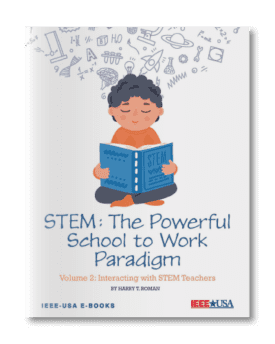

STEM – The Powerful School to Work Paradigm – Vol. 2: Interacting with STEM Teachers
FREE to IEEE Members
Non-Members: $2.99
Roman makes a passionate case for more STEM experiences throughout a student’s educational journey. He is a strong believer that STEM education should not be taught in a silo, cordoned off in the science wing. By including STEM across the curriculum, Roman believes students will be better prepared for the jobs of tomorrow — the nature of which we may not even grasp today.
The author does not just consider promoting STEM education is the right thing to do; he maintains it is critical for businesses, by helping to assure a stable supply of well-trained, productive, STEM employees.
Roman offers six ways businesses and their employees can promote STEM education:
- Visit Schools
Throughout his engineering career, Roman has worked with local teachers, students and schools, bringing the excitement of real-world problem solving to the classroom. He encourages other STEM employees to do the same, visiting classrooms and bringing personalized STEM work project stories. He views these visits, not as lectures, but more as “tales around the campfire” — leaving plenty of room for asking questions and investigative dialogue.
- Celebrate Inventors and Inventions
Roman has tremendous respect for inventors, from Thomas Edison to his own father (whose footsteps he has followed). Roman himself holds 12 U.S. patents, has created numerous engineering inventions, and received many awards for his endeavors.
.
He encourages companies to help educators develop materials and resources to prompt young minds to consider invention as a critical business process. He also suggests helping students identify inventors (and their inventions) from their own states.
- Hire Teachers for the Summer
Roman advocates for hiring teachers during the summer, to help them bring real-world STEM back to their classrooms in the fall. He stresses the teachers “should be directly engaged in ongoing projects, and allowed to interact with project team members.”
.
He encourages sharing first-hand experiences with teachers, such as demonstrating the value of oral and written communication skills, and the need to document results. The author notes close collaboration also exposes teachers to the wide variety of STEM jobs available, and can help breakdown stereotypes about the STEM workforce. Roman also suggests teachers develop lesson plans for their classrooms, based on what they have learned from their summer experiences.
- Hold Invention Competitions
Roman has run several invention contests and notes that these contests can excite and engage students but warns that running an invention contest is not for the “faint of heart.” In the book, he runs through details of the resources you will need if you want to start a contest in your area. Roman concludes that despite the work and resources involved, the “downstream fun and rewards are worth it.”
- Offer In-Service Seminars
All schools require teacher development, and Roman suggests offering yourself for in-service seminars. Some seminars that Roman has presented include:
-
- Unleashing imagination and creativity
- Promoting invention with student project teams
- Dealing with failure in the invention process
- Understanding the engineering design process
- Promoting creativity through the use of “what if” scenarios
- STEM Challenge Activities
IEEE has honored Roman with a Meritorious Achievement Award for developing continuing education products for IEEE members. He suggests companies develop materials and challenge activities that teachers can use in the classroom based on the real-world challenges their businesses face. Several of Roman’s other IEEE-USA-published e-books offer creative STEM challenges. Check them out in the IEEE-USA Shop.
Volume 2 – Interacting with STEM Teachers is the second book in Harry Roman’s STEM: The Powerful School to Work Paradigm series. Along with the first book in the series — Volume 1: Cool stuff about STEM — both books are free for all IEEE members at IEEE-USA’s shop. Non-members pay $2.99 each.
Throughout his engineering career, Harry T. Roman has worked with schools, bringing the excitement of real-world problem solving to the classroom and was named a Distinguished Technology Educator by New Jersey Technology Education and Engineering Association. He has published more than 550 scientific papers, articles, and books.






